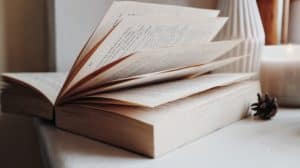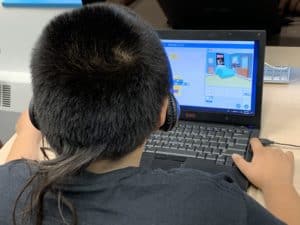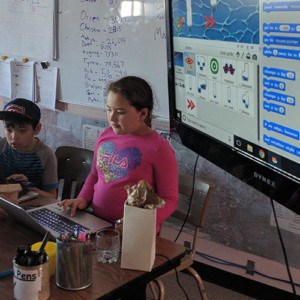Section Navigation
Introduction
The purpose of this training module is to provide a learning tool that Pinnguaq facilitators, teachers and parents can use to teach youth about oral stories in Indigenous culture. As stories differ between Indigenous nations, facilitators should identify which stories would have the most regional relevance to achieve the greatest impact. Facilitators will begin by telling a creation or oral story or invite a local elder into the the workshop to share the creation story and then discuss its importance to cultural preservation and the passing of knowledge and culture through generations. The session will close with a story telling activity that allows youth to record and share their own stories.
Learning Goals
The goal of the module is for students to learn about the importance of intergenerational oral storytelling in Indigenous culture.
Vocabulary
Intergenerational - Relating to, involving, or affecting several generations.
Creation Story - What Indigenous peoples call their origin stories of the world and their nations. They inform a people of how they came to be and how the world around them was created.
Teachings - The educational, cultural, spiritual, and natural lessons that are passed down from one generation to another.
Wampum - Traditional artistic belts made of shells and beads that were used to tell stories of agreements, treaties, and important moments in time. Before pen and paper or technology, wampum was one of the first forms of physical document to keep records for Indigenous nations.
Guiding Questions
- What is an oral story?
- Has anyone ever told oral stories before?
- How has technology changed the way that we tell stories now?
- What do you want to tell future generations about yourself or your people?
- What would happen if all our stories or teachings were to disappear?
Curriculum Links
This module provides an opportunity to address curriculum expectations in Language Arts, English, Social Studies, History, Heritage & Culture. Students will be introduced to ideas of oral storytelling and its importance to Indigenous culture. This lesson is geared to students in Grades 5 to 8.
Materials
- Paper wampum template – Download Template
- If students find the above paper wampum template too small, they can use our simple grid to plan out their oral story – Download Assets Folder (ZIP)
- A recording device or microphone on a computer or laptop
- Speak Pipe (a free online recorder program that can be downloaded on a laptop or phone) – Download Speak Pipe
Non-Computer Activity
Part A
Find a historical creation story of a local Indigenous nation and summarize it to the group. This is a great opportunity for a local Elder or community member to visit the classroom to share a creation story.
- Two examples are the Cree Stories: The Granddaughter who was Eaten By A Big Fish, and The Lily Root (see stories further below).
- Students can also choose from story books or videos on YouTube.
- Ask them to try and remember parts of the story that stand out to them.
- Talk about how oral stories were used to preserve culture and teach generations of people.
- Why else is it important for stories about our families and nations to be preserved and passed down to future generations?
The Granddaughter Who Was Eaten By A Big Fish
This is a story about Gookum (Cree word for “grandmother”) and her mischievous granddaughter, Beulah. Beulah was a very curious little girl. She was always wandering off from the camp, looking for adventures. Gookum was always telling her to listen. One day, Gookum asked Beulah to get some water from the lake so she could make soup.
“Whatever you do, don’t go swimming in the lake alone,” said Gookum.
“Why not?” asked Beulah.
“Because there is a giant fish in that lake, and he will catch you and swallow you up if you swim too far.”
“Eeeeeya, Gookum. I’m not afraid of a big fish.”
So, Beulah went off to collect the water. Oh, it was a nice warm day. The sun shone brightly.
A squirrel chattered as she walked along the path.
“Go away, silly squirrel. I am busy.”
A butterfly flew around the girl. She ran around in circles trying to catch the butterfly until it flew away. “I am really hot now,” Beulah said to herself.
Finally, Beulah came to the lake. She went to the big rock where Gookum had showed her to stand to get water. She dipped her buckets in the lake. They filled up quickly. Those buckets were heavy now. She had to be very careful when she carried them to the shore, they were so heavy. With a cup, she scooped out the little sticks and leaves that floated on the top. She was ready to carry them back now.
Carrying the buckets made Beulah tired. She lay down next to the water, in a nice spot on a large flat rock. The sun shone on her. She was very hot, so she took off her shirt.
A blue jay landed in a tree next to the path.
The blue jay squawked at her.
“You noisy old bird. Stop disturbing me.” The blue jay flew away.
Beulah decided to have a quick swim, just to cool off before she took the water back for Gookum. She removed all of her clothes and dived in.
The water was nice and cool. Beulah was a good swimmer. She decided she would swim out as far as she could. As she swam out, Beulah saw a huge silver flash in the water. It was a great big fish, and with one gulp, it swallowed her whole! Beulah found she was trapped in the stomach of the huge fish Gookum had warned her about.
“Oh no,” she cried, “I should have listened to Gookum!”
Beulah had been gone a long time. Gookum thought that she had found an adventure and forgotten to get water. There was no point in worrying about her — there were chores to be done around camp. She cut wood and made dinner. When Beulah wasn’t home by night, Gookum was worried, but she knew the little girl was able to take care of herself in the woods.
The next day, Beulah still was not back. Gookum needed food, so she gathered the fishing net and went down to the lake. She caught six fish. One was a huge creature that stretched as long as her arms and more. That big fish would feed a whole family for a week.
She started cutting up all the fish. When she finally got to the big fish, she slid the knife into the belly. Beulah jumped out, very much alive.
At first, Gookum was startled, but she quickly realized it was Beulah, who was covered head to toe in slimy, sticky fish innards.
She shook her head at Beulah, and began to laugh at her. “I told you not to swim in the lake.” Beulah bowed her head and said nothing. She just went to the lake to clean off all the smelly fish slime.
The Lily Root
Emily Muskrat was ten years old. She lived with her family on a reserve in Manitoba, north of Lake Winnipeg. Emily had a younger sister named Hattie whom she often looked after.
Emily’s father worked for a First Nations organization as a community health worker. He visited First Nations communities to help develop local health programs. Emily’s mother was a teacher’s aide at the local school. Emily took care of Hattie on Saturday afternoons when her parents went to town to shop for food.
One Saturday, Emily was playing cat’s cradle. Hattie watched her weave the tiny string between her two hands. As Emily continued to create designs, Hattie said, “how me how to do that.” pointing to the cradle between her sister’s hands.
Emily replied, “Spread your hands and fingers.” Emily wrapped the string around Hattie’s thumbs. “Move your fingers like this,” she said as she showed Hattie how to wind the string between her fingers and hands. It was not easy for Hattie to make a cat’s cradle.
While Hattie struggled to make a cradle, Peter Crane rode his old bicycle past the girls. Emily made a face at Hattie when they saw Peter because Peter often wore old and worn-out jeans when he played and rode his bicycle. Neither girl spoke to Peter as he went by.
As the two sisters were playing, Old John walked along the path by their home. He saw the two girls playing cat’s cradle. Hattie showed Old John her first cat’s cradle. Old John smiled and waved the girls over to him. Old John spoke softly to the girls. “I’m going to tell you a story,” he said. “It is about the lily root.” He motioned to the two girls to sit beside him on the small bench.
Old John began his story. “One day, Shomis (used in certain Ojibway-speaking communities to mean ‘old man’ or ‘grandfather’) and his grandson were walking in the bush. They came upon a small river with a big pond. Shomis saw some water lilies in the pond. He asked his grandson to get him a lily root. Lily roots were important to Shomis. When he dried the root and ground it into powder, it became medicine. Shomis would use this medicine to keep healthy.
His grandson removed his boots and socks. Then, he rolled up his pant legs. When he stepped into the pond, he felt the mud ooze between his toes. Shomis stood on shore and pointed to the lily plant he wanted.
When the boy reached the lily plant, his pants and legs were wet and muddy. The oozing muck from the bottom of the pond was smelly and dirty. He reached into the water quickly to pull out the root.
“Be careful,” Shomis told him. “You must not break the root when you pull it up. The medicine will be spoiled if it is taken from a broken root.”
When his fingers were around the root, his grandson gave a hard yank. Nothing happened. He put his other hand around it.
“Be careful, now,” instructed Shomis.
When he yanked the second time, the boy’s shirt became wet with the muddy water. But the root still did not move. The boy could hear his grandfather on the shore. “Reach deeper with both hands,” said Shomis.
Very slowly, the boy bent over the beautiful white lily flower. He reached with both hands for a better grip around the root. His shirt sleeves were soaked. He pulled hard. The root refused to budge.
Finally, he realized he would have to get all wet with the muddy water. It still smelled. He held his breath. Quickly, his face went under water. He bent right over the plant with both hands deep around the stubborn root. He pulled and pulled. When the root came free he almost fell over in the water.
He walked back to shore to Shomis. He was wet from head to toe. His skin was itchy. Mud covered his feet, his pants, and his shirt. He carried the lily in his muddied hands. At one end of the plant was the beautiful white flower. At the other end was the muddy root.
As Shomis cleaned the mud from the lily root, he hummed softly. Then he cut off the flower.
He looked at his grandson who stood beside him. He was wet and muddy. His clothes smelled like the muddy pond. His toes and feet were still slippery with mud. Shomis laughed at the sight of his grandson.
Shomis held the lily root very gently. “This will make me feel strong and healthy,” he said to the boy. Next to Shomis, the beautiful white flower lay discarded on the ground. “The root is more important than the flower,” he said. “Many people are interested only in the pretty flower,” he said. “Remember the lily root.”
Hattie and Emily sat quietly next to Old John. They listened carefully to everything Old John told them. The story was over. Old John stood up. He patted Hattie on the head and walked away. Emily and Hattie walked to their house. They, too, would remember the lily root.
Part B
Using the template provided (either the Wampum or grid template):
- Have students think about a story they want to tell, about themselves or their people, to future generations so that it does not get lost.
- Draw that story onto the template using whatever art work or symbols they choose.
- Have the youth hold up their drawing and tell their story to the rest of the group.
Computer Activity
Once students are more familiar with oral stories have them record either their own story, or a family story that has been passed down for generations.
Note about how to use Speak Pipe:
- Press the Record button.
- Students may have to press “Allow” to allow the use of their device’s microphone on that website.
- After students have made their recording, they can either click “Save on Server” or “Restart” to record it again.
Conclusion
After students have told their stories to the group, have them break off into pairs. Each student will take a turn being the listener and try to retell the story they heard. If they cannot remember the entire story, the story can be replayed for them. This exercise tests students listening and memory skills, and it will be interesting to see which parts of the story stand out strongly enough to be retold. This activity demonstrates why it is so valuable to record our oral stories. If our oral stories are not recorded, the ideas and messages they tell can be lost between generations, or permanently. Remembering and reciting oral stories accurately was a skill that knowledge keepers needed to master traditionally to be able to preserve their cultures and worldviews. They did not have the technological advances that we have today that make telling and documenting our stories so much easier. This session encourages students to reflect on the importance of cultural stories and how technology has impacted how we tell and receive them.
Resources
- Video – Aboriginal Dreamtime Story
- Collections Canada (Archived) – Our Voices Our Stories
- Indigenous Corporate Training Inc. – 11 Things You Should Know About Aboriginal Oral Traditions



